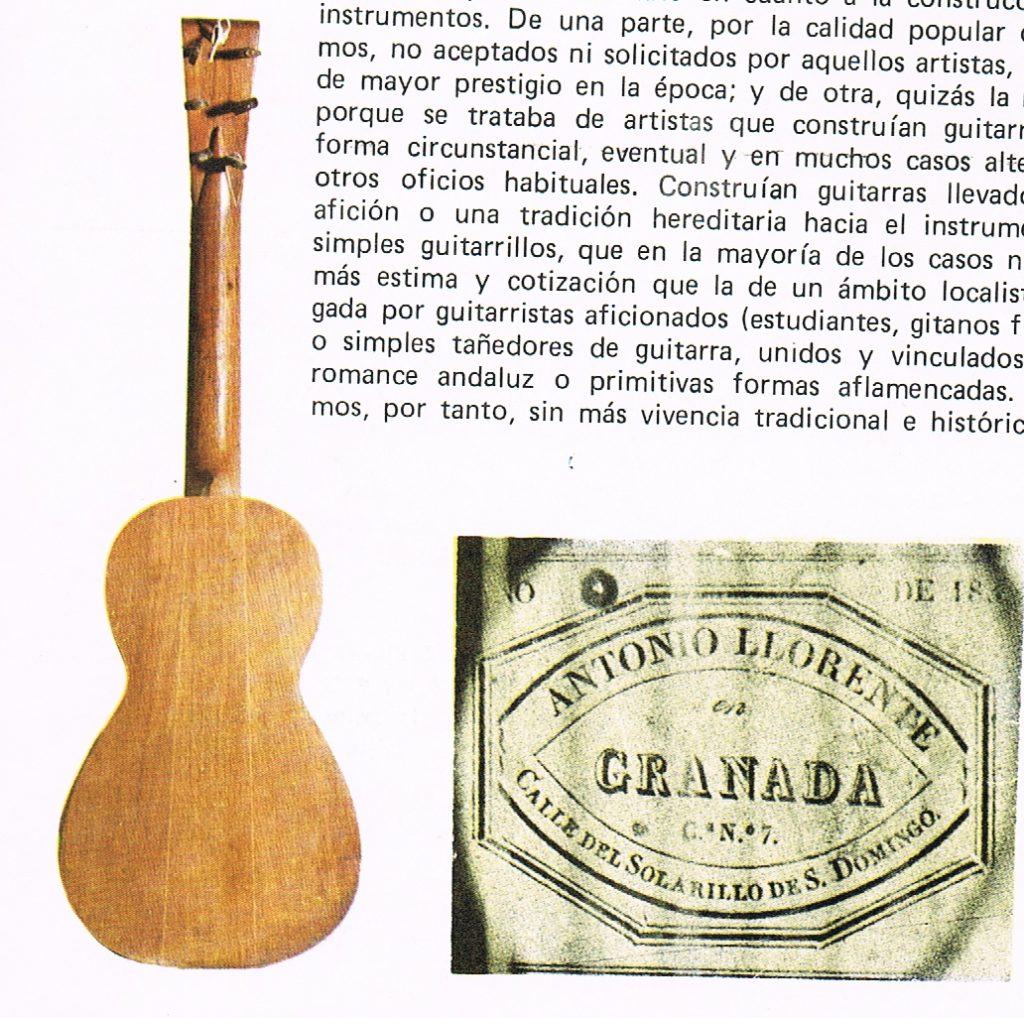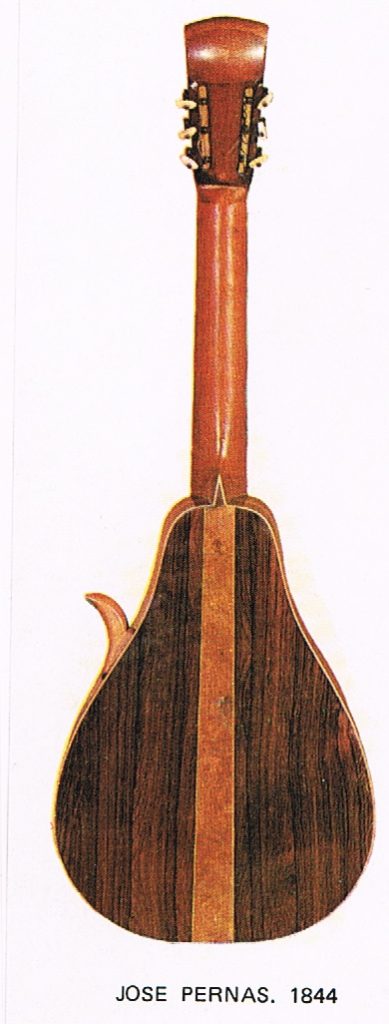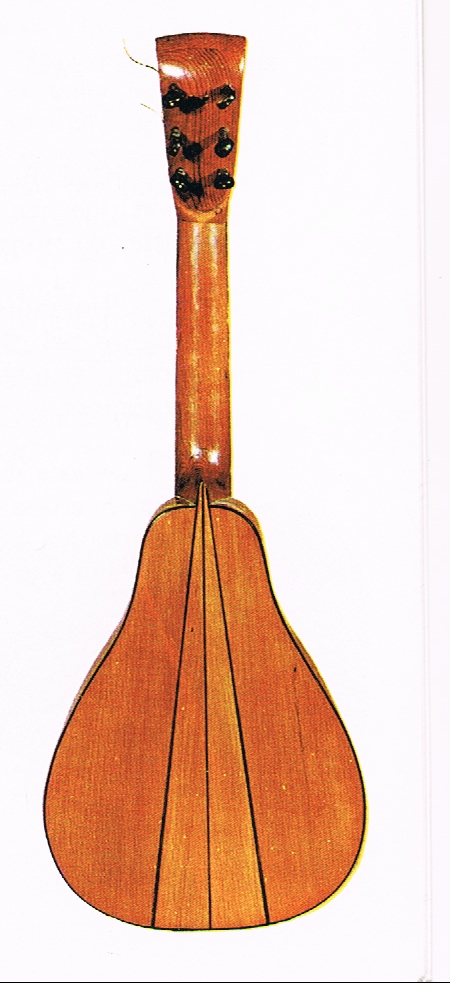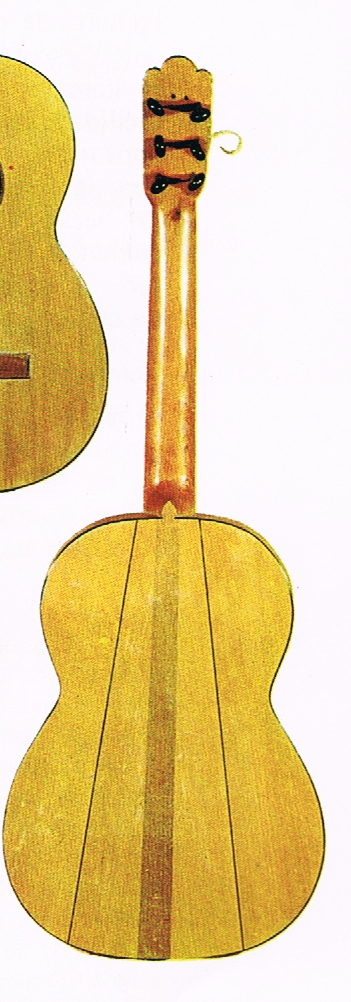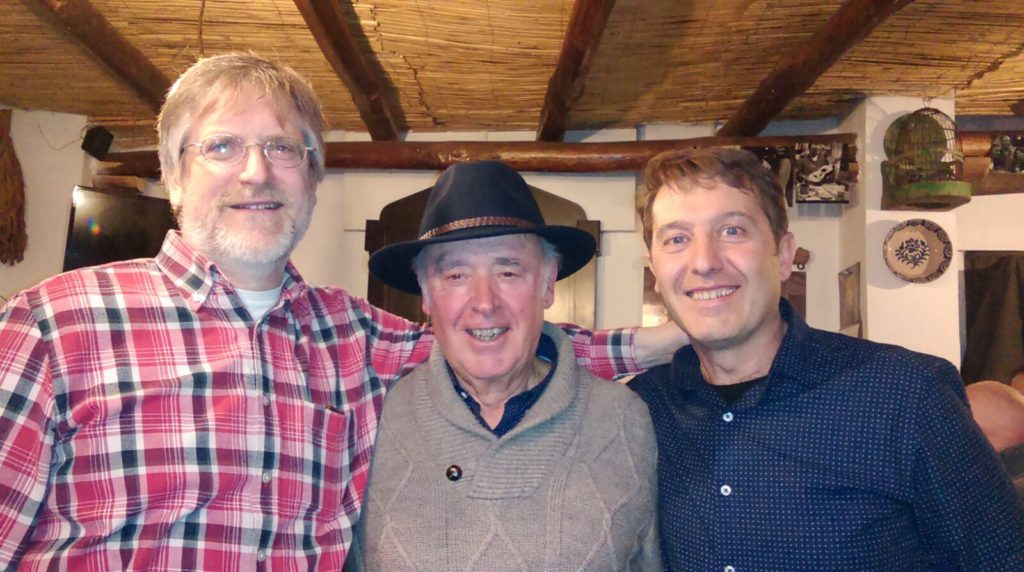 One of the original Granada School makers has just retired and saw fit to invite us all for a meal so that we could celebreate his over 40 years of building guitars. All of the established makers were there and I was happy to meet a few that I don’t see very often. To see everyone sitting down for a drink and talking about days gone by you never would have known that there had ever been problems between any of the makers. A few group photos were taken but I haven’t seen the results yet. I hope to be able to publish one here. We had a great time and between those that sing and those that play we had music all afternoon. Rafael Moreno and José López Bellido have fine singing voices and Juan Garcia Fernandez plays as well as many professional players.
One of the original Granada School makers has just retired and saw fit to invite us all for a meal so that we could celebreate his over 40 years of building guitars. All of the established makers were there and I was happy to meet a few that I don’t see very often. To see everyone sitting down for a drink and talking about days gone by you never would have known that there had ever been problems between any of the makers. A few group photos were taken but I haven’t seen the results yet. I hope to be able to publish one here. We had a great time and between those that sing and those that play we had music all afternoon. Rafael Moreno and José López Bellido have fine singing voices and Juan Garcia Fernandez plays as well as many professional players.
Category Archives: Granada guitar-makers
Granada, ciudad de la guitarra
 Spanish version here. Yesterday we spent the afternoon setting up the exhibition “Granada, ciudad de la guitarra” which opens today in the Sala Zaida, Caja Rural. The exhibition opens with a quote from Evaristo Valentí’s article “La nueva escuela” and takes us through the development of the guitar (thanks to Asociación para el Estudio de la Guitarra RCSMVE) to leave us with a great collection of guitars made in Granada. The only exception is the Antonio de Torres guitar from the Centro de Documentación Musical de Andalucia which is there to remind of us of the fact that Torres built his first guitar in Granada.
Spanish version here. Yesterday we spent the afternoon setting up the exhibition “Granada, ciudad de la guitarra” which opens today in the Sala Zaida, Caja Rural. The exhibition opens with a quote from Evaristo Valentí’s article “La nueva escuela” and takes us through the development of the guitar (thanks to Asociación para el Estudio de la Guitarra RCSMVE) to leave us with a great collection of guitars made in Granada. The only exception is the Antonio de Torres guitar from the Centro de Documentación Musical de Andalucia which is there to remind of us of the fact that Torres built his first guitar in Granada.  A series of videos showing guitar-makers at work, a selection of historical tools, jigs and documents are on display as well. The highlights of the exhibition will be the concerts, live workbenches and the conferences. Here you can see guitar-maker Juan García Fernández, who will have his workbench onsite for a few periods throughout the exhibition, admiring the work of Pernas, Caro and del Valle. Thanks again to Gloria Medina for all the work and of course to Fundación Caja Rural and Poli Servián for the iniative. Click here for the programme.
A series of videos showing guitar-makers at work, a selection of historical tools, jigs and documents are on display as well. The highlights of the exhibition will be the concerts, live workbenches and the conferences. Here you can see guitar-maker Juan García Fernández, who will have his workbench onsite for a few periods throughout the exhibition, admiring the work of Pernas, Caro and del Valle. Thanks again to Gloria Medina for all the work and of course to Fundación Caja Rural and Poli Servián for the iniative. Click here for the programme. 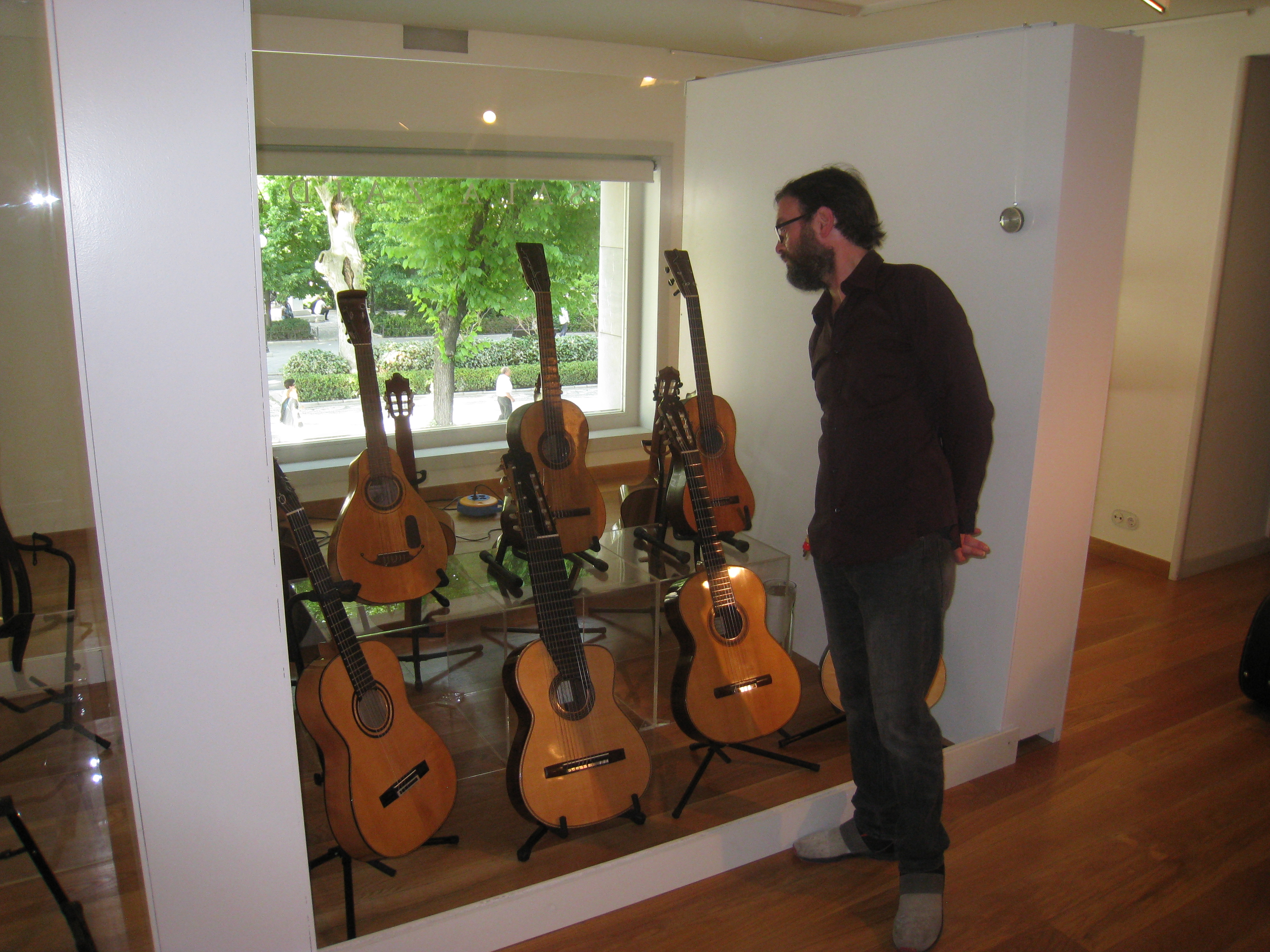
Buying a guitar in Granada
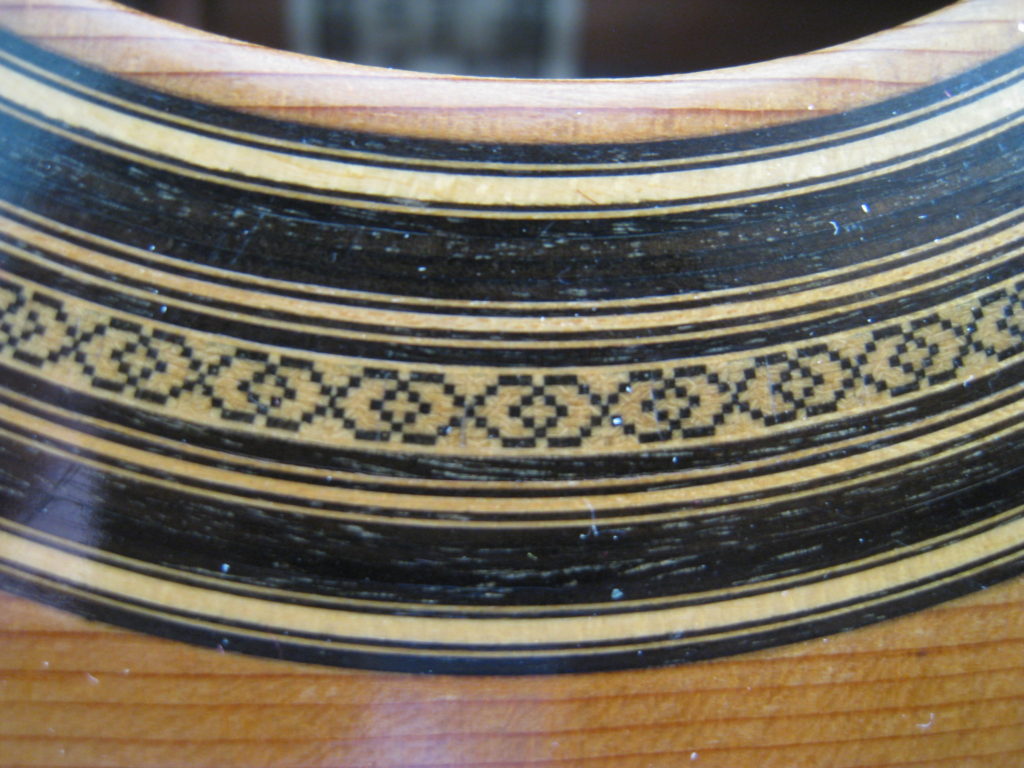 A recent visitor to my workshop complained that despite Granada’s reputation as a great place to find a guitar, he was having very little luck. The makers he was interested in or whose guitars he had tried, or was able to try now, did not have anything available for sale. It is true that the better makers are making guitars on order and sending them off to clients as soon as they are finished so you have to be here at the right time if you want to sample the wares. One way to avoid this problem is through contact with the guitar-makers. These days a lot of them use email and will answer. These are not neccesarily reccommendations although I will say that these workshops do not sell factory-made instruments but rather guitars made on the premises by the guitar-makers.
A recent visitor to my workshop complained that despite Granada’s reputation as a great place to find a guitar, he was having very little luck. The makers he was interested in or whose guitars he had tried, or was able to try now, did not have anything available for sale. It is true that the better makers are making guitars on order and sending them off to clients as soon as they are finished so you have to be here at the right time if you want to sample the wares. One way to avoid this problem is through contact with the guitar-makers. These days a lot of them use email and will answer. These are not neccesarily reccommendations although I will say that these workshops do not sell factory-made instruments but rather guitars made on the premises by the guitar-makers.
- Juan M. García Fernández
- Juan Miguel Carmona
- Manuel Bellido
- Mauricio Bellido
- Jesús Bellido
- Paco Santiago Marín
- Luis Santiago
- José Luis Vigil
- Andrés Daniel Marvi
- Bernd Martin
- Lucas Martin
- Antonio Marín
- José Marín Plazuelo
- José González López
- René Baarslag
- Aarón García Ruiz
- Mario Aracama
- Henner Hagenlocher
- Juan Labella
- Franz Butscher
- Eduardo Duran Ferrer
- Stephen Hill
- Antonio Raya Ferrer
- Ana Espinosa Rodríguez
- John Ray contact
Rafael Moreno, Francisco Alba and José López Bellido do not have webpages.
Sometimes it is possible to hold off sending a guitar to the client so that someone can see it. In the past I have had a guitar available which I have been asked to reserve long enough so that a client could come and see it and maybe take it. I am always encouraging folks to come to Granada to buy a guitar as it is a treat to meet the builders and the city is beautiful. However, there are alternatives; a few shops where you can find a nice asortment of guitars from Granada. Below is a list of shops which usually have guitars by a number of Granada makers.
- Casa Luthier in Barcelona, Spain
- Aura Guitar Shop in Tokyo, Japan
- Jean-Marc de Beys near Toulouse, France
- Kent Guitar Classics in Sevenoaks, England
- The Classical Guitar Store in Philadelphia, U.S.A.
- Guitarras de Luthier in Madrid, Spain
- Kurosawa at various locations in Japan
- RIck Falkiner’s Guitar Centre near Sydney, Australia
Three-piece backs
One of the characteristics of the early Granada School was the way they used darts, inserts and in general multiple pieces for their backs. Some still do it today but it is not so much a signature of Granada. Here are some photos, mostly from “Un siglo de la guitarra granadina” by Manuel Cano, a sixteen page supplement from 1975. One must assume that these backs were composite for economic reasons especially given the hard times in Andalucia back then but many of them are so nicely laid out that a lay-person would surely never consider that possibility.
Rondalla and the traditional spanish strings
 The most common musical formation 30 years ago in this part of Spain was the “rondalla”, a group of players using bandurrias, laudes and guitars. The guitar was of course the rythmic accompaniment and the smallest (bandurria) was the the solo voice. Dances, parties and any social event would see at the very least a group of three players and in the case of a concert there might be as many as fifty. The larger groups often had a few bass guitars too. Today, choirs, orchestras and marching bands have become more common but you can still see groups, recordings and even festivals dedicated to the spanish string trio.
The most common musical formation 30 years ago in this part of Spain was the “rondalla”, a group of players using bandurrias, laudes and guitars. The guitar was of course the rythmic accompaniment and the smallest (bandurria) was the the solo voice. Dances, parties and any social event would see at the very least a group of three players and in the case of a concert there might be as many as fifty. The larger groups often had a few bass guitars too. Today, choirs, orchestras and marching bands have become more common but you can still see groups, recordings and even festivals dedicated to the spanish string trio.
The relationship between these three instruments was a very important one also for the guitar-maker. Years ago everyone started out building all three instruments but today very few makers build fine bandurrias and laudes. Very few musicians are looking for a bandurria that costs in the thousands of Euros.
The book that I talk so much about tells the story of Benito Ferrer who played the bandurria for dances and how that led him to starting a workshop which in a way resulted in the consolidation of the Granada School of Guitar-making.
The trade has changed in many ways over the years and this is just one of the things that has been lost in the specialization. The older guitar-makers here in Granada are fond of telling us how a guitar-maker must know how to choose a standing tree, fell it, cut it up to dry, maximize the number of sets and then store them for seasoning. Of course these days very few have that luxury or knowledge. One of the reasons for the excellent tradition in Granada is that almost all of the makers who started in the 70s or earlier came from wood-working trades, specifically cabinet-making.

